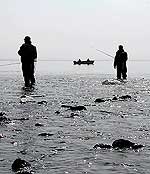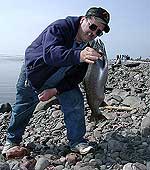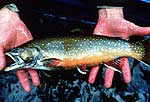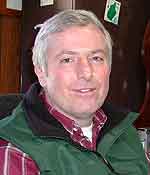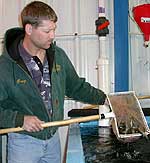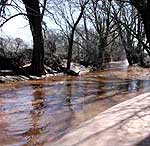By Stephanie Hemphill
Minnesota Public Radio
May 6, 2002
The Department of Natural Resources announced in March it will no longer stock lake trout in much of Lake Superior. Decades of work to control lamprey, improve water quality, and limit harvest have apparently paid off. Lake trout are making a comeback. The restoration success story is welcome news to anglers and environmentalists. Now, some people are turning their attention to another native trout, the coaster brook trout. That species has been struggling to survive in Lake Superior and its tributaries for more than 100 years.
| |||
| |
|
||
|
|||
About 15 miles up the shore from Duluth, the French River tumbles into Lake Superior. On each side of the river, anglers are perched on the rocky lakeshore, eyes glued to their lines. Every now and then, a fish takes the bait, and one of the anglers gets busy reeling in a fish and conking it on the head.
They're mostly catching kamloops, a kind of rainbow trout. Kamloops are not native to Lake Superior. The DNR stocks them from the fish hatchery across the road.
People used to catch coaster brook trout here, but there aren't many of them around anymore.
Ask a young angler whether he's ever caught a coaster, and chances are you'll get a blank stare. He may never have heard of them, because they've been scarce for so long. An older man says, "There aren't any coaster brook trout. You're dreaming!"
But one local, who's fished here for 30 years, says he saw someone catch a coaster just a couple of weeks ago.
"You very seldom get them, but when you do they're nice. They're so clean, and the colors are so beautiful. And there isn't any better eating," he says, relishing the memory of his last catch, years ago.
| |
|
|
|
||
Coasters are a kind of brook trout. They hatch in rivers, and then swim downstream to grow up in the lake. Several years later, they return to spawn in the river in which they were born. Coasters can get much bigger than trout that stay in the streams. The biggest coaster on record was 14-1/2 lbs. That's about three times the size of the typical brook trout.
For a freshwater fish, coasters sport dramatic colors. Their backs are marked with squiggly ripples. Their sides are sprinkled with bright red dots surrounded by blue circles. Their fins are edged with a bright white line. When they spawn, their bellies turn iridescent orange.
There used to be lots of coasters around Lake Superior, as well as in parts of Lake Michigan and Lake Huron. They were a popular sport fish. As early as the 1850s, people were coming from all over the country, and even from Europe, to catch them.
Too many people came, and caught too many of them. By the early 1900s, coasters had practically disappeared. Only a few viable populations are left, mostly in the wilds of Canada and Isle Royale.
DNR Area Fisheries Supervisor Don Schreiner says coasters are especially vulnerable to overfishing. They are typically easier to catch than other trout, and that's why they almost disappeared. They were overfished years before the region was settled.
"There were no roads back then," Schreiner says. "People came in by boat, they came in by train. There are accounts of people standing on the shore and on the riverbank and catching hundreds of brook trout."
| |
|
|
|
||
After the fishermen had virtually wiped out the coasters, lumberjacks arrived on the scene. They cut down the big trees that shaded the streams. They floated timber down the rivers, blasting out logs that lay in the water, slowing its flow. Today, the rivers flowing into Lake Superior are much more susceptible to flooding and sedimentation.
Then the DNR began stocking other fish here, so anglers would have something to catch. They imported salmon from the Pacific Northwest, brown trout from Europe, and rainbow trout from Alaska, including the kamloops and steelhead strains. All these new arrivals compete with the few native brook trout that still survive in Lake Superior streams.
Some people want the DNR to try to restore the native brook trout. But others like to catch the big salmon, and the feisty steelhead. Don Schreiner says the DNR has to balance those competing demands.
"I think everybody cares about coaster brook trout - as long as it doesn't cost them anything personally," he says. "If I have to give up my favorite species in favor of a coaster brook trout, I might not be willing to do that. That's the sort of thing we see."
| |
|
|
|
||
Four years ago, the DNR imposed a 20-inch minimum size and a restricted season on coaster brook trout. Those rules seem to be helping. Recent surveys have turned up more coasters than expected.
Schreiner says it's possible the native trout will bounce back, if people leave them alone. He says lots of work will have to be done to improve the habitat, but that's a long-term challenge. It could be 50 years before there are enough coasters for people to catch in significant numbers.
Some groups are trying to push things along a little faster. Chippewa Indian tribes and the U.S. Fish and Wildlife Service are cooperating on several restocking projects.
The Red Cliff Tribal Fish Hatchery near Bayfield, Wis., specializes in rearing coaster brook trout. Hatchery manager Greg Fischer says one million eggs hatch here every year.
Each fall, workers take eggs from the females, fertilize them, and put them in the incubator. Over the winter, the eggs hatch.
Some are released as tiny fry just a few months old. Others are kept in tanks for a year and a half. Workers mark these older fish to keep track of them after they're released.
| |
|
|
|
||
"We have fin-clipping parties, where for several days we fin-clip each one of the fish," says Fischer. "And when we're stocking anywhere from 50,000 to 80,000 of these larger fish a year, that's a lot of marking."
The Red Cliff Band and the U.S. Fish and Wildlife Service do surveys every fall. That's how they know what happens to the fish.
Greg Fischer doesn't want to stock streams forever. He hopes a lot of these fish will find good places to spawn - so the population can grow.
Young fish from the Red Cliff hatchery might someday find a home at Whittlesey Creek. Flowing into Lake Superior near Ashland, Wis., Whittlesey Creek is becoming a refuge for coaster brook trout. U.S. Fish and Wildlife biologist Lee Newman says it's a promising spot for spawning.
"This creek is so cold in the summertime, it hurts your legs to wade in it," Newman says. "And in the winter it never freezes, because of the springs that feed it."
Newman says the ideal spot for a coaster nest, or redd, is a gravelly stream bottom with springs or groundwater seeping beneath the gravel. That provides a constant flow of oxygen through the eggs. The scientific name for brook trout is Salvelinus fontinalis. Newman translates it as "little trout of the spring."
Newman says if his team decides to stock coasters here, they'll start by planting eggs and very young fry directly over the springs. That's what they did on the Grand Portage Chippewa reservation in Minnesota. Newman says it worked there.
| |
|
|
|
||
"We've captured pairs of adults that were radio-tagged and captured on their spawning beds, and two years later we've caught the exact same pair on the exact same spawning beds," says Newman.
He says that shows the coasters are returning precisely to their home locations. The key, Newman thinks, is planting eggs or very small fry. In the first few days or weeks of their lives, the chemistry of the stream is imprinted in their brains. Even after years of wandering, sometimes many miles up and down the Lake Superior shore, they can find their way back to the stream where they were born.
Newman agrees with the DNR's Don Schreiner that habitat is critical to the success of the coasters. The Fish and Wildlife Service is buying up land along Whittlesey Creek, to protect the creek from development and to reduce sedimentation. Newman says they will probably restrict angling to protect spawners.
As a young man, Lee Newman fished a lot of brook trout out of Lake Superior. Now, he's excited about helping to bring them back.
"When you go out and do stream surveys in the fall, and catch some of these three, four, or five-pound brook trout, their size and their colors are just so unbelievable," says Newman. "Something about the brook trout and the fall colors and everything is so 'right' and so appropriate. It's a real privilege to work with these fish."
Something so right - but so fragile and vulnerable to human mistakes. Biologists still have a lot of questions about how to help the coaster brook trout. But its future looks a little brighter.
More Information
